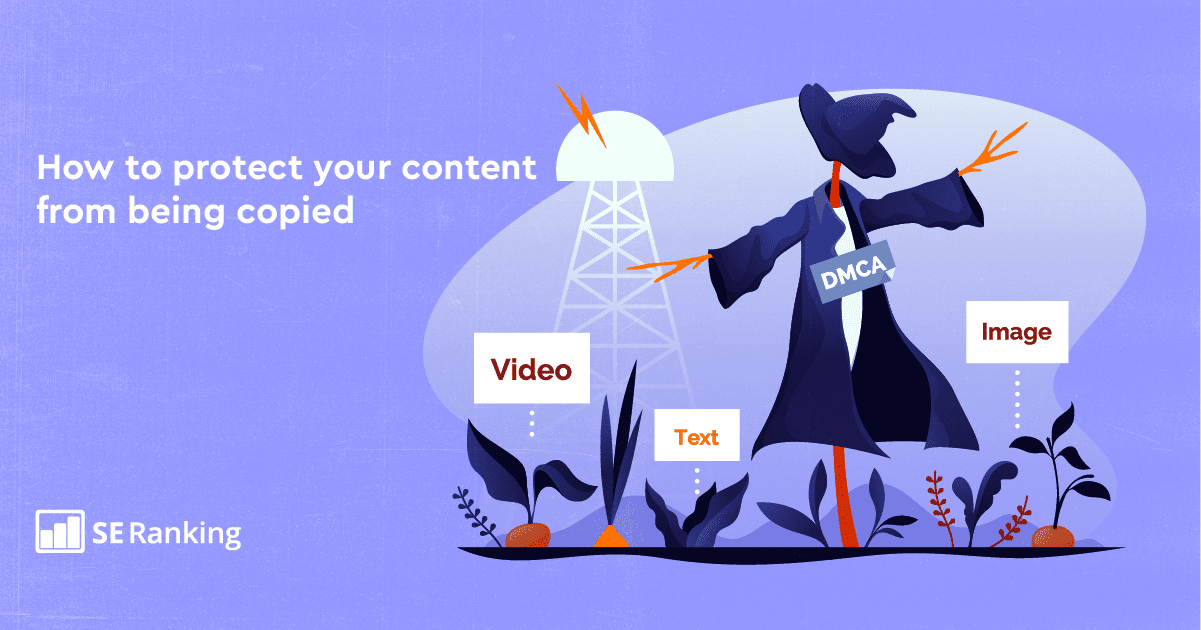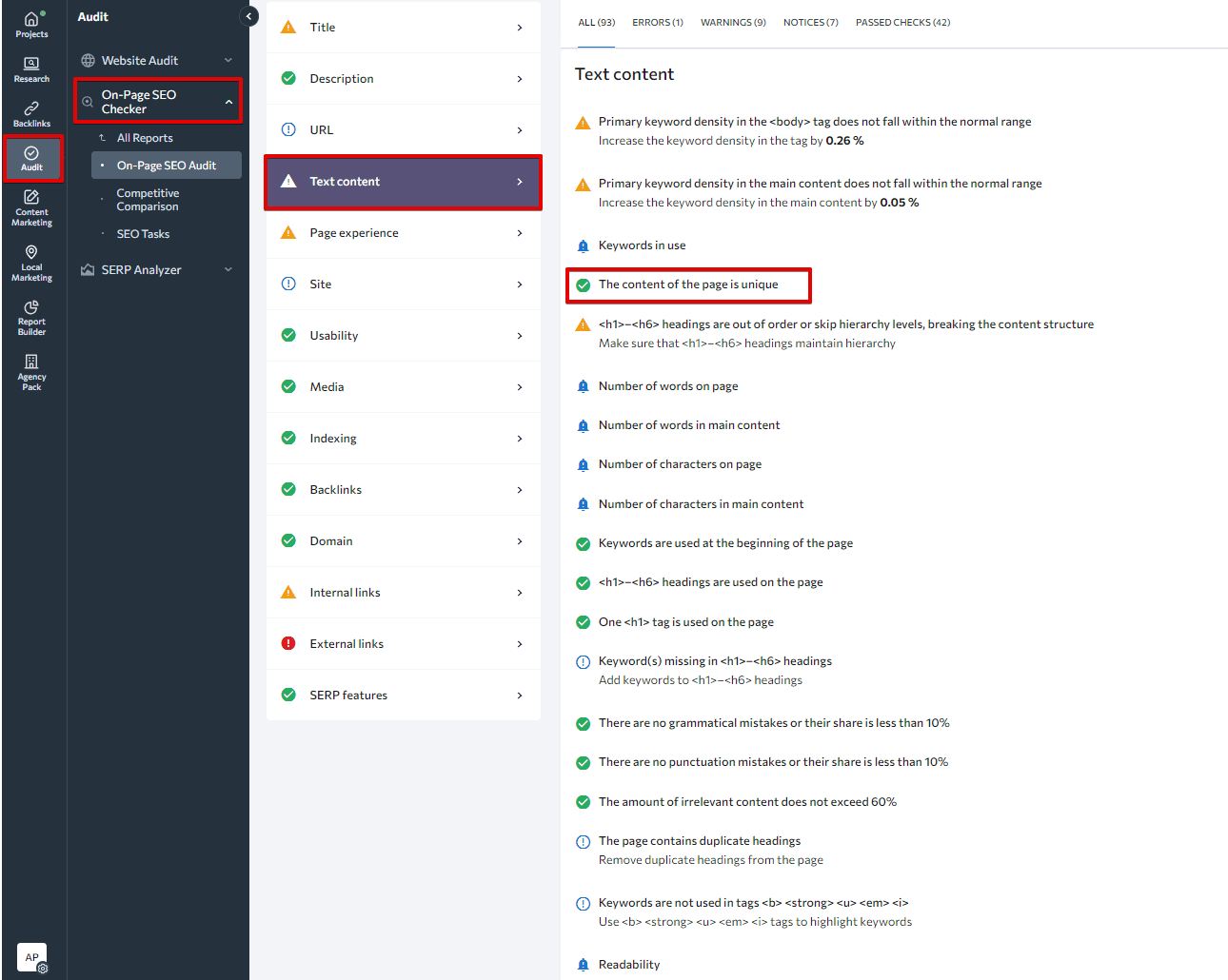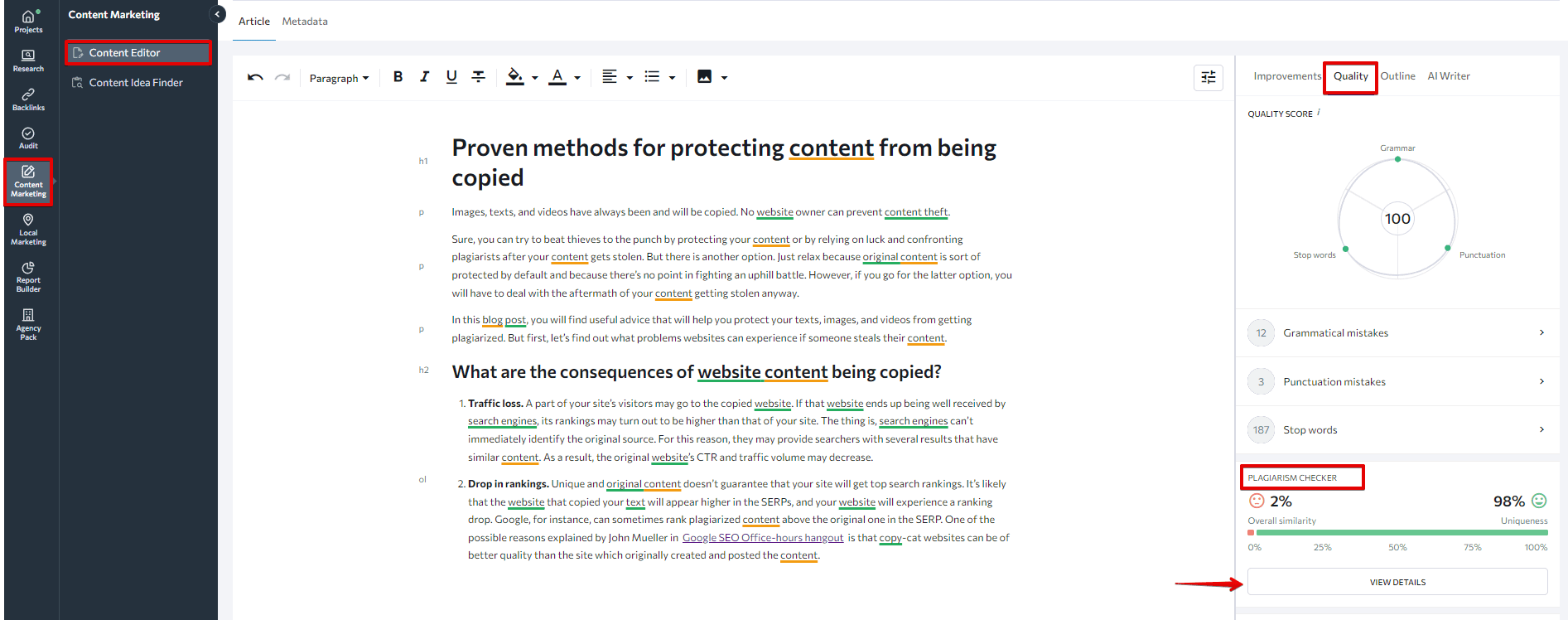
-
Content plagiarism involves unauthorized use of online materials, including articles, images, videos, and website designs.
-
Consequences of content theft include traffic loss, drops in search rankings, decreased reader loyalty, and potential search engine sanctions.
-
To detect stolen content, use manual search, Google Alerts, image recognition tools, plagiarism detection services, and specialized SEO tools like SE Ranking.
-
If your content has been stolen, contact the plagiarist or search engine support, or file a DMCA complaint.
-
Protect textual content through methods like hidden source information, internal linking, and using social signals to establish authorship.
-
Safeguard images and videos using watermarks, encryption, secure players, and metadata techniques.
-
With the rise of AI-generated content, be cautious of unintentional plagiarism. Be transparent about AI use and add your unique expertise. Thoroughly review content and adhere to EEAT standards.
Images, texts, and videos have always been and will be copied. No website owner can prevent content theft.
Although you can protect content by relying on luck and confronting plagiarists after your content gets stolen, there is another option. Thankfully, original content is protected by default. And if you decide to confront plagiarists, you will have to deal with the aftermath of stolen content anyway.
In this blog post, you will find out what content plagiarism is, how to spot it, and useful tips for protecting your texts, images, and videos from plagiarism. Let’s dive in.
What is content plagiarism?
Content plagiarism happens when someone uses or repurposes your online materials without your permission. This includes copying your articles, using your pictures or videos, taking your music, or even copying your website design. Plagiarists might steal content by copying it word for word, paraphrasing, or translating it to another language. Some even use content scraping tools to automatically grab content from other websites.
How do you find out if your online content was stolen?
If you suspect that your content has been copied, there are several ways to check:
Using a search engine
Enter the title of your article in the search bar and look through the results to see if they contain similar texts.
Example: If your article is titled “10 Best SEO Practices for 2024”, type this exact phrase into Google and review the search results for similar content.
The downside of this method is that it requires you to manually review the content on each page shown in the search results. It will only work if you suspect specific websites are intentionally copying your content.
Using Google Alerts
Choose any unique line or phrase from your content and put it in double quotes into the search field. Then, click the Create Alert button. Now, when the system detects copied pieces, you’ll get a Google alert message with details on the website stealing your content.
Example: If your article contains the unique phrase “AI-powered SERP analysis for predictive ranking”, set up a Google Alert for “AI-powered SERP analysis for predictive ranking” to get notified if this phrase appears elsewhere.

For a more detailed guide on setting up and optimizing your Google Alerts, including advanced tips and best practices, refer to the ultimate guide on how to set up Google Alerts.
Use specialized SEO tools
SE Ranking has several handy tools to help you combat unauthorized content copying and protect your original work.
SE Ranking’s AI-powered On-Page SEO Checker helps website owners optimize their site’s pages for target search queries and find out how unique their content is. It assesses your page with 94 parameters, including its structure, keyword usage in the text and headings, readability and content scores, and other vital technical elements. For each issue it finds, the tool gives you specific, actionable recommendations to help you improve your page and get it to the top of the SERPs.

Our AI-powered Content Editor is another powerful content creation and optimization tool. It features an in-built Plagiarism Checker that scans your content and compares it to a large database to verify its originality. It shows you the percentage of your text matching other online sources, its overall uniqueness score, the number of matching phrases, and the number of sources with similar textual content. To ensure you don’t get false positives from your own website pages, you can exclude URLs or entire domains from the plagiarism check.

Using image search and recognition tools
Image search and recognition tools like Tineye are powerful resources for detecting unauthorized use of your visual content.
Example: We have a custom infographic about “AI Overview presence in search”. Uploading it to Tineye shows us if it appears on other websites without our permission.

You can also try Google Images to check for search similarity. The good thing about Google Images is that it allows you to find visually similar images and discover if your image has been slightly modified.
Using plagiarism detection services
You can check for plagiarism using online tools like Unicheck, Plagiarism Checker, Grammarly, etc.
Example: Copy and paste a portion of your blog post into Plagiarism Checker to see if it detects matches on other websites.

Alternatively, tools like Grammarly or Quetext can scan the whole content piece for plagiarism.
What can you do if your content gets stolen?
The Berne Convention Implementation Act of 1988 and the Digital Millennium Copyright Act (DMCA) regulate the international protection of original content owners. The rights of content creators are also protected by the civil code of the country where they are registered. This protection comes into force as soon as the content is published. In practice, these laws protect content owners only hypothetically, because many plagiarists can, unfortunately, get around them.
Contact the plagiarist
The first step in detecting plagiarism should be contacting the plagiarist directly. Contact information will likely be provided somewhere on the site. Once you get it, send a personal message describing the problem.
Sometimes a website owner may not even be aware that the content on their site or images and videos they use have been stolen. This happens, for instance, when you hire an irresponsible person to do the job. Sometimes, all you have to do is inform the website owner of the problem and that’s it—no more complicated steps.
But if you don’t get any response, you can send a second, more serious email saying that you will bring the case to court with evidence that the stolen content belongs to you. Sometimes this works to scare off plagiarizers, getting them to remove the copied text from their site.
Contact search engine support
If contacting the plagiarizer doesn’t help, try reaching out to your search engine’s support team. This can help you remove stolen content, at least from the search results, but may not always help, especially if you don’t have solid evidence. In such cases, pages with duplicate content will not be removed from the search results. Correspondence with tech support will help you in court if your case goes to trial.
For Google, you can report about stolen content via this form.
File a complaint according to the DMCA law
You can report copyright infringement under the US DMCA, or file an offsetting order if another person has filed such a complaint against you. Before you file a copyright infringement, you should prepare all the necessary documentation to help the court identify you as the original author of the published material.
Here’s how to file a DMCA notice of infringement:
- The author files a notice of infringement to an authorized agent of the service provider (or “removal notice”) asking the provider to remove the stolen content from the website of the plagiarist.
- The copypasted page is removed from the search results if the service agent is registered with the US Copyright Office.
- The owner of the copycat website is notified about the limitation of their content showing in search results in response to complaints that the provider received under the DMCA law.

The last resort is to take it to court. Be prepared to hire a lawyer and collect tangible evidence of your original authorship of the content.
How to protect your online content from theft
How to protect text content from being stolen
If someone steals your original work, take all possible measures to protect your existing and future publications.
This is especially relevant to new websites whose pages are not immediately ranked by search engines after posting. If your text is copied and pasted onto a larger, more popular website, you may be wrongfully accused of copypasting.
Here are several methods for protecting your content from plagiarists and proving your authorship.
- Hidden block with information about copy-pasted text. A fragment referring to the original source is inserted into the text. A plagiarist can copy it without even noticing that he copied the text with the name of the site or the name of its company owner.
- Disabling text selection highlighting using CSS styles (for example, ‘noselect’). This will work even if script execution is disabled. However, this method will not work if the thief opens the page’s code and copies the text from there.
- Internal linking. Insert links to other pages of your website within your text. If someone copies your content, the links leading to your site will be copied too.
- Restricting copying to clipboard. The text will be copied, but the malefactor cannot copy it onto the clipboard.
- Using social signals. Allow users to share your article, “like” it, and leave a comment. You can even create the first activity on your own. Doing so will help you prove your authorship using the **** you shared it.
- Using special pinging services. You can connect tools such as FeedBlitz to send automated messages about a new post on your website to various services. You can also use a special WordPress plugin or ask your developers to help you.
- Cross-posting on other websites. Post news about publications on your website on various social platforms.
- Notarization of website pages. This is expensive and takes some time but it’s 100% effective.
- Preventing pre-publishing sharing. Sometimes, theft occurs even before publishing the content (this gives you no chance to prove authorship afterward). Don’t let your team share any materials with third parties before publication. The easiest way to do it is to use Pics.io DAM. This tool enables you to restrict the sharing of materials!
How to protect images from being stolen
- Using watermarks. You can create watermarks using Adobe Photoshop, Digimark, Watermark, and other similar programs.
- Downloading an empty file or a file of a nonexistent format. As a result, the downloaded image will not open, and the plagiarist will seek another place to copy images.
- Restricting copying via the context menu. You can do this by editing JavaScript, CSS, jQuery, or by using CMS plugins.
- Digital marks on images. The information about the camera that was used to take photos, the ****, the time, and the location are solid evidence of ownership of your images.
- Using the IPTC Core “Creator” metadata field to indicate the creator/author of an image. You can do it in Adobe Photoshop, IPTC is supported in JPEG and TIFF photo files.
- Creating an anchor list consisting of unique text fragments. It should contain fewer than 100 characters. This method accelerates content indexing.
- Picking up pieces of images. You can cut an image into several parts and then post them together using a code. Plagiarists will get only a part of an image if they try downloading it.
- Posting licensed images. Google processes licenses. As a result, a ‘Licensable’ mark will appear on the images on your site.
How to protect video content from being stolen
- Use a watermark or owner identifier. This is the most popular option because it marks videos as copyrighted even when plagiarists try to capture them from the screen.
- Device blocking. In this case, the video player on your site links to a particular device type. This limits the opportunities of users of your site because they have to watch videos on specific devices.
- Use Advanced Encryption Standard (AES). In this case, AES doesn’t allow thieves to watch the downloaded video and protects video content from getting stolen with the help of advanced plugins.
- Use a secure video player. A secure player hides the video download link from both users and plugins. For example, JW Player offers DRM-protected streaming and download protection features.
Methods that don’t protect your content from being copied
- Using a Google+ account linked to the website. This method doesn’t work anymore because the social network no longer exists.
- Using built-in scripts to prohibit content copying. When dealing with websites with built-in scripts, plagiarists can still access the page source code or turn off scripts in the browser, making this method ineffective.
- Putting a link to the source at the end of the text. When you insert a text fragment into a text field, the cursor goes to the end of that fragment, where the mentioned link is placed. Since it cannot remain unnoticed, this method is ineffective.
The rise of generative AI ****** has made it even trickier to prove content originality. This holds especially true given how many unintentional cases of content plagiarism exist. Content creators may use AI tools to reinforce their writing process, believing they are creating original content. However, since AI ****** are trained on vast amounts of existing data, they may inadvertently reproduce phrases, ideas, or structures from their training data. This can lead to portions of their AI-assisted work closely mirroring existing content.
This modern challenge makes it harder to prove originality and spot plagiarism. Content creators must be cautious when using AI tools, and always add their own expertise, value, and personal experience to any AI-generated content. This also ensures your content adheres to EEAT standards.
What are the consequences of copying website content?
No matter the intent, copying website content can lead to severe, hard-to-spot consequences that are hard to combat. Let’s look at the various problems websites can experience if someone steals their content.
Traffic loss
Some of your site’s visitors may go to the copied website instead. If search engines start favoring that website, it may even begin getting higher rankings than your site. And since search engines can’t immediately identify the original source, they may provide searchers with several results with similar content. As a result, the original website’s CTR and traffic volume may decrease.
Drop in rankings and duplicate content
Having unique content doesn’t guarantee your site will get top search rankings. The website that copied your text can easily appear higher in the SERPs and cause your website to experience a ranking drop. Google, for instance, can sometimes rank plagiarized content above the original one in the SERP. One of the possible reasons explained by John Mueller in Google SEO Office-hours hangout is that copy-cat websites can be of better quality than the site which originally created and posted the content.

John Mueller
Senior Search Analyst / Search Relations team lead
…Maybe it’s worthwhile to also invest in improving the quality of your website overall… Not just that one article that apparently people like.
Also, if you’re the original creator of high-quality content and you regularly update it, search engines will most likely recognize and prioritize your pages. This is because Google uses various signals to “determine which site is the original”.
Check our blog post on content duplication to dive deeper into its technical aspects and impact on SEO.
Decreased reader loyalty
Some readers may assume that you’re the one who stole content, not the other way around. Your site may ultimately lose credibility, especially if it’s less popular, younger, or looks worse than the site whose owners copied your content.
Search engine sanctions
Sometimes websites that produce original content undergo search filtering while copycat sites are left unpunished. This can happen if search engines incorrectly identify or recognize the content’s original source.
From a business perspective, content theft also encourages unfair competition. This is especially true and harmful for e-commerce sites. Firstly, competitors can copy your product descriptions. Secondly, they can steal your offer. With minimal effort, they’ll have ready-made texts at their disposal and can make their offer more profitable than yours.
Summing up
You cannot completely protect your content from being copied but that doesn’t mean you shouldn’t try. Use one or several of the protection methods mentioned above.
If plagiarists still succeed at stealing your content despite all the measures you’ve taken to secure it, contact them immediately. If the plagiarists don’t respond to it, contact your search engine’s support team and provide them with evidence. The last option is to collect evidence of your authorship and take legal action.
No matter the outcome, taking proactive steps to protect your work and preparing to defend it is essential to minimizing damage from plagiarism.

![YMYL Websites: SEO & EEAT Tips [Lumar Podcast] YMYL Websites: SEO & EEAT Tips [Lumar Podcast]](https://www.lumar.io/wp-content/uploads/2024/11/thumb-Lumar-HFD-Podcast-Episode-6-YMYL-Websites-SEO-EEAT-blue-1024x503.png)

